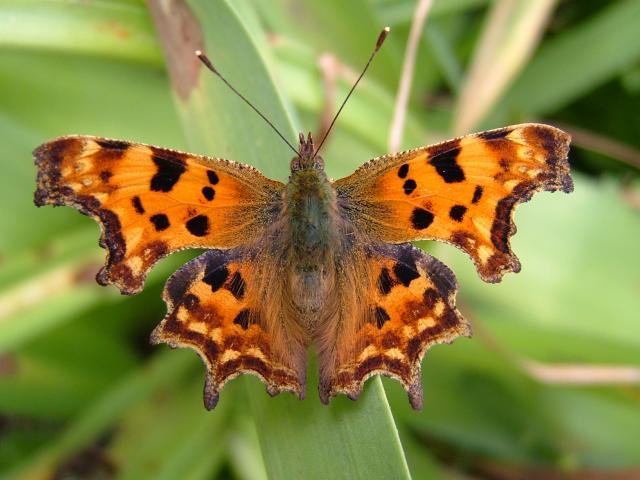Polygonia c-album
Comma ( Polygonia c -album), summer generation
The C- Falter ( Polygonia c-album; Syn: Nymphalis c -album) is a butterfly ( butterfly ) of the family Nymphalidae ( Nymphalidae ).
- 5.1 Notes and references
- 5.2 Literature
Description
The moths reach a wingspan of 40 to 50 millimeters. The wings are colored very variable. They have orange-colored tops, marked with a black, brown and yellow spot pattern. The underwings are dark brown, light brown, gray or yellowish. Striking here is the white, C -style drawing, which gave its name to the butterfly. The moths of the first generation usually have bright underwings that the late first and second are rather dark colored and in addition have a slightly dark green mottling.
The caterpillars are about 30 mm long. They are colored orange-brown and have black markings. The rear two -thirds of the body are colored completely white on the entire back, the front third is shown in yellow and black. For this, the existing all over the body spines on the back are each white or yellow. On the sides are orange-brown patterned. On the head capsule in addition there are two black spines. Young caterpillars are colored black in the root.
Occurrence
They come in Europe to 66 ° N.Br., North Africa and Asia to Japan. They often live along forest paths and edges. You are bound significantly to hygrophile mesophilic forests and thickets. Also especially preferred southern exposure sallow, hazel and elm bushes. In gardens, the butterflies like to use fruit bushes like gooseberries and currants and nectar-rich flowers garden as summer lilac nectar plants. In high summer, the butterflies also like to suck on fallen fruit. In the spring you can watch the butterfly on flowering catkins. They are almost everywhere quite frequently.
Way of life
Flight times and caterpillars
The moths fly depending on the region either in a generation in early July and after winter to early June or in two generations from late June to late July and mid-August and after winter to early June of the following year. In the southern Balkans and in Greece they fly in three generations of May to October. The track is from May to July and from May to June and from July to August.
Food of the caterpillars
Serve as caterpillar food plants:
- Goat Willow (Salix caprea )
- Hazel (Corylus avellana )
- Flutter elm ( Ulmus laevis)
- Field elm ( Ulmus minor)
- Mountain elm ( Ulmus glabra)
- Hops ( Humulus lupulus)
- Stinging nettle (Urtica dioica)
- Gooseberry (Ribes uva- crispa )
- Red currant ( Ribes rubrum)
Development
The females lay about 250 eggs individually onto the forage plants. The caterpillars hatch after two to three weeks. They live as a loner and spend the day on the underside of leaves on. After six weeks they are fully grown. The doll is also the moths built as very exceptional. They are deeply constricted in the middle and have the back forward a distinct cusp. Near the constriction they have six shiny metallic stains. The second generation overwinters as moths.









.jpg)